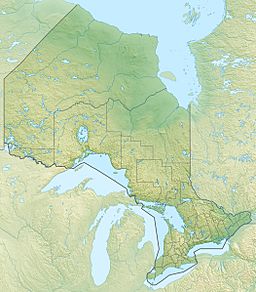Lake Ojibway facts for kids
Quick facts for kids Lake Ojibway |
|
|---|---|

Glacial Lake Agassiz and Lake Ojibway (7,900 YBP)
|
|
| Location | Ontario & Quebec |
| Coordinates | 48°N 80°W / 48°N 80°W |
| Lake type | former lake |
| Etymology | Chippwa Nation |
| Primary inflows | Laurentide Ice Sheet |
| Primary outflows | Ottawa River valley |
| Basin countries | Canada |
| First flooded | 9,160 years before present |
| Max. length | 1,314 mi (2,115 km) |
| Max. width | 365 mi (587 km)212 mi (341 km) |
| Residence time | 1900 years in existence |
| Surface elevation | 820 ft (250 m) |
Lake Ojibway was a prehistoric lake in what is now northern Ontario and Quebec in Canada. Ojibway was the last of the great proglacial lakes of the last ice age. Comparable in size to Lake Agassiz (to which it was likely linked), and north of the Great Lakes, it was at its greatest extent c. 8,500 years BP. The former lakebed forms the modern Clay Belt, an area of fertile land.
Lake Ojibway was relatively short-lived. The lake drained in what must have been a catastrophic and dramatic manner around 8,200 years BP. One hypothesis is that a weakening ice dam separating it from Hudson Bay broke, as the lake was roughly 250 m (820 ft) above sea level. A comparable mechanism produced the Missoula floods that created the channeled scablands of the Columbia River basin.
A recent analysis states it has not been conclusively determined whether the lake drained by a breach of the ice dam, by water spilling over the glacier, or by a flood under the glacier. It is also not conclusively known whether there were one or more pulses, and the route the water took to reach Hudson's Bay has not been determined.
The draining of Lake Ojibway is a possible cause of the 8.2-kiloyear event, a major global cooling that occurred 8,200 years BP.


